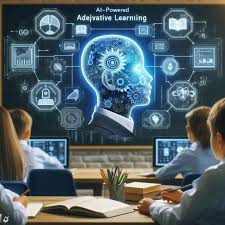AI-Powered Adaptive Learning: The Future of Personalized Education
AI-Powered Adaptive Learning: The Future of Personalized Education

The world of education is undergoing a significant transformation, thanks to the rise of Artificial Intelligence (AI). With AI-powered adaptive learning systems, students no longer have to follow the traditional “one-size-fits-all” approach. Instead, AI allows for a tailored learning experience that adapts to the unique needs, pace, and learning style of each student.
At the core of this transformation are eLearning platforms that leverage AI algorithms to track student performance, assess learning gaps, and provide customized learning paths. These platforms deliver personalized content, real-time feedback, and continuous support to ensure every student reaches their full potential. This article explores the concept of AI-powered adaptive learning, its benefits, and its impact on the future of personalized education.
1. What is AI-Powered Adaptive Learning?
AI-powered adaptive learning refers to a personalized learning approach where educational content and instruction are customized to meet the needs of each student. This method uses AI algorithms, machine learning, and data analytics to assess a student’s learning habits, identify areas of improvement, and adjust the pace, difficulty, and content of lessons accordingly.
Unlike traditional education, where all students are taught the same content at the same pace, adaptive learning creates a dynamic environment where each student receives an individualized learning experience. This allows students to master concepts before moving on, improving overall academic performance and confidence.
2. How AI-Powered Adaptive Learning Works
The process of adaptive learning is powered by AI systems that collect and analyze student data in real time. Here’s how it works:
- Data Collection: The system tracks student behavior, including completion rates, quiz scores, and time spent on tasks.
- Analysis and Insights: AI analyzes this data to identify student strengths, weaknesses, and areas where they need support.
- Personalization: The platform customizes lesson plans, activities, and quizzes to suit the student’s learning needs.
- Feedback Loop: Students receive immediate feedback on their performance, allowing them to correct mistakes and improve.
- Continuous Improvement: The system continues to adapt as students progress, ensuring the content remains relevant and challenging.
This process ensures that every student receives a unique learning path that aligns with their pace, skills, and learning objectives.
3. Key Features of AI-Powered Adaptive Learning
AI-powered adaptive learning platforms come with a range of features that support personalized education. These features are designed to enhance student engagement, motivation, and performance.
1. Personalized Learning Paths
AI-driven systems analyze student performance and create custom learning paths for each student. The platform identifies knowledge gaps and offers tailored lessons, assignments, and practice exercises.
Benefits:
- Students can focus on areas where they need improvement.
- Lessons are tailored to suit individual learning speeds.
- Students receive personalized support and guidance.
2. Real-Time Feedback and Assessments
Gone are the days of waiting for days or weeks to receive graded assignments. AI-based platforms provide instant feedback on quizzes, tests, and assignments.
Benefits:
- Students receive immediate feedback, helping them learn from their mistakes.
- Feedback increases student engagement and motivation.
- Teachers can focus on providing additional support, as AI handles grading.
3. Predictive Analytics for Early Intervention
AI-powered platforms use predictive analytics to identify at-risk students before their performance declines significantly. By analyzing behavioral data, such as missed deadlines or low engagement, teachers can provide timely intervention.
Benefits:
- Early intervention reduces dropout rates.
- Students receive personalized support when they need it most.
- Teachers can monitor student progress in real time.
4. Interactive and Gamified Learning
Gamification elements such as badges, points, and leaderboards make learning fun and interactive. Gamification increases student engagement and encourages healthy competition.
Benefits:
- Students stay motivated and engaged in the learning process.
- Gamified elements promote friendly competition and boost participation.
- Students receive rewards and recognition for their achievements.
5. Virtual Tutors and AI-Powered Support
AI-powered virtual tutors offer 24/7 support to students, providing explanations, tips, and learning resources whenever needed. These tutors simulate the experience of having a one-on-one teacher.
Benefits:
- Students get help anytime, anywhere, without waiting for a teacher’s availability.
- Virtual tutors promote independent learning and problem-solving.
- Students can overcome learning challenges at their own pace.
4. Benefits of AI-Powered Adaptive Learning
AI-powered adaptive learning brings numerous benefits to students, teachers, and educational institutions. These benefits highlight the transformative potential of personalized education.
1. Personalized Learning for Every Student
Students receive a customized learning experience that adapts to their strengths, weaknesses, and learning speed. This personalized approach increases student engagement and success.
Impact on Students:
- Students progress at their own pace, reducing stress and frustration.
- Learners receive content that matches their skill level, leading to better knowledge retention.
- Students build confidence as they experience success in their academic journey.
2. Real-Time Feedback and Immediate Corrections
Real-time feedback allows students to correct mistakes and learn from them instantly. Unlike traditional education, where students have to wait for days to receive their grades, AI enables instant feedback.
Impact on Students:
- Students learn from mistakes without delay.
- They remain motivated as they see their progress in real time.
- The feedback loop encourages continuous improvement.
3. Increased Student Engagement and Motivation
Gamification elements like badges, points, and leaderboards make learning more engaging. Students remain motivated to complete assignments, lessons, and challenges to earn rewards.
Impact on Students:
- Students are more likely to participate in interactive lessons and activities.
- Gamification increases motivation and creates a fun learning environment.
- Students feel a sense of achievement when they reach milestones.
4. Early Detection of At-Risk Students
AI systems identify students who are at risk of underperforming and notify teachers for early intervention. This proactive approach ensures no student is left behind.
Impact on Students:
- Students receive personalized support and intervention.
- Teachers can offer timely guidance, preventing dropouts and poor performance.
- Students gain confidence as they overcome challenges with the support of teachers and AI.
5. How AI-Powered Adaptive Learning Benefits Teachers
While the benefits for students are clear, AI-powered adaptive learning also supports teachers in significant ways.
1. Reduced Administrative Burden
AI automates routine tasks like grading, attendance tracking, and performance reports, allowing teachers to focus on personalized instruction and student support.
2. Actionable Insights
AI provides teachers with performance data, learning patterns, and student engagement reports. This data enables teachers to tailor their instruction to address individual student needs.
3. Improved Student-Teacher Collaboration
Teachers receive alerts when students are at risk of underperforming. This allows for timely intervention, one-on-one coaching, and personalized support.
6. The Role of eLearning Platforms in Adaptive Learning
eLearning platforms play a pivotal role in enabling AI-powered adaptive learning. These platforms serve as the foundation for personalized education by hosting AI-driven tools, resources, and interactive learning features.
Features of eLearning Platforms
- Cloud-Based Learning: Students can access lessons and assignments from any device.
- Data-Driven Insights: eLearning platforms provide analytics on student performance and engagement.
- On-Demand Learning: Students have access to lessons, resources, and virtual tutors 24/7.
Why eLearning Platforms Matter
eLearning platforms enable education to become more flexible, personalized, and accessible. They create opportunities for students from all backgrounds to access quality education from anywhere in the world.
7. The Future of AI-Powered Adaptive Learning
The future of AI-powered adaptive learning is filled with exciting possibilities. Here’s a glimpse of what lies ahead:
- Emotion AI: AI will detect student emotions (like frustration or boredom) and adjust lessons accordingly.
- Voice-Activated Learning Assistants: Students will interact with AI-powered voice assistants for help.
- Immersive Learning Experiences: AI will merge with Augmented Reality (AR) and Virtual Reality (VR) to create immersive learning environments.
- Smarter Predictive Analytics: Advanced AI will offer better early warning systems to support at-risk students.
Conclusion
AI-powered adaptive learning is transforming the future of education. By leveraging the capabilities of AI, eLearning platforms create personalized, flexible, and engaging learning experiences for students. From personalized learning paths and real-time feedback to AI-driven virtual tutors and predictive analytics, the future of education is becoming more student-centered and data-driven.
Students can now enjoy self-paced learning, while teachers benefit from reduced workloads and actionable insights. As AI technology continues to evolve, so will the potential for personalized education. Institutions that embrace AI-powered adaptive learning will provide students with a superior educational experience, preparing them for academic and career success in the 21st century.








